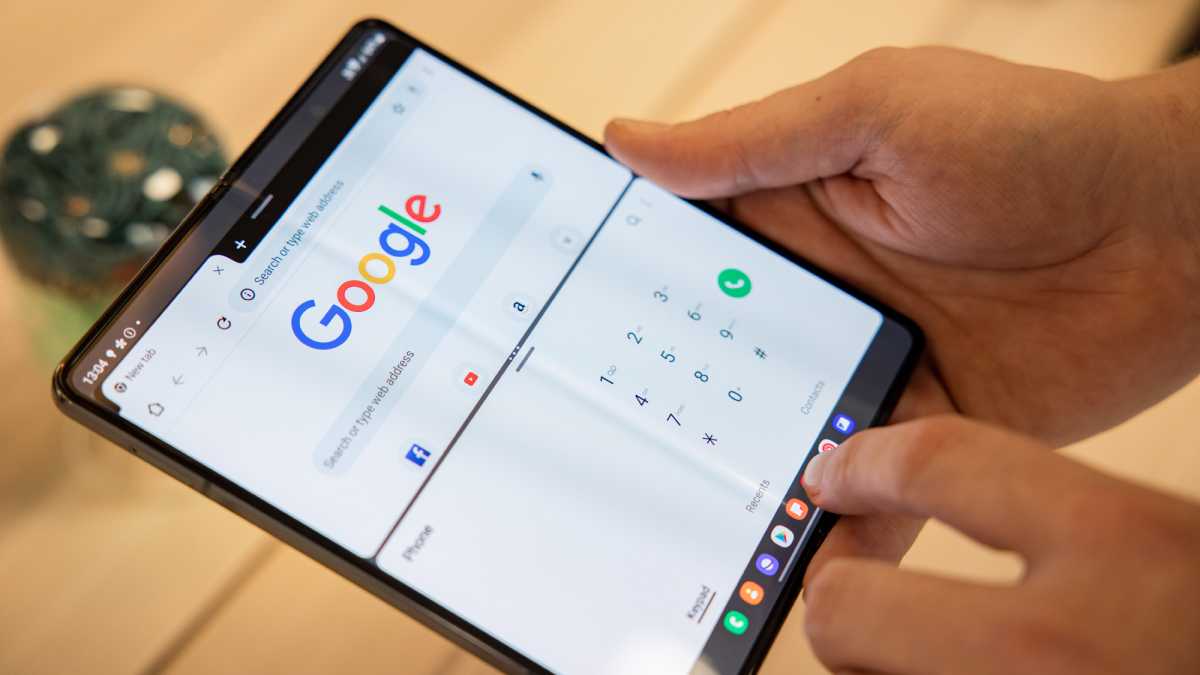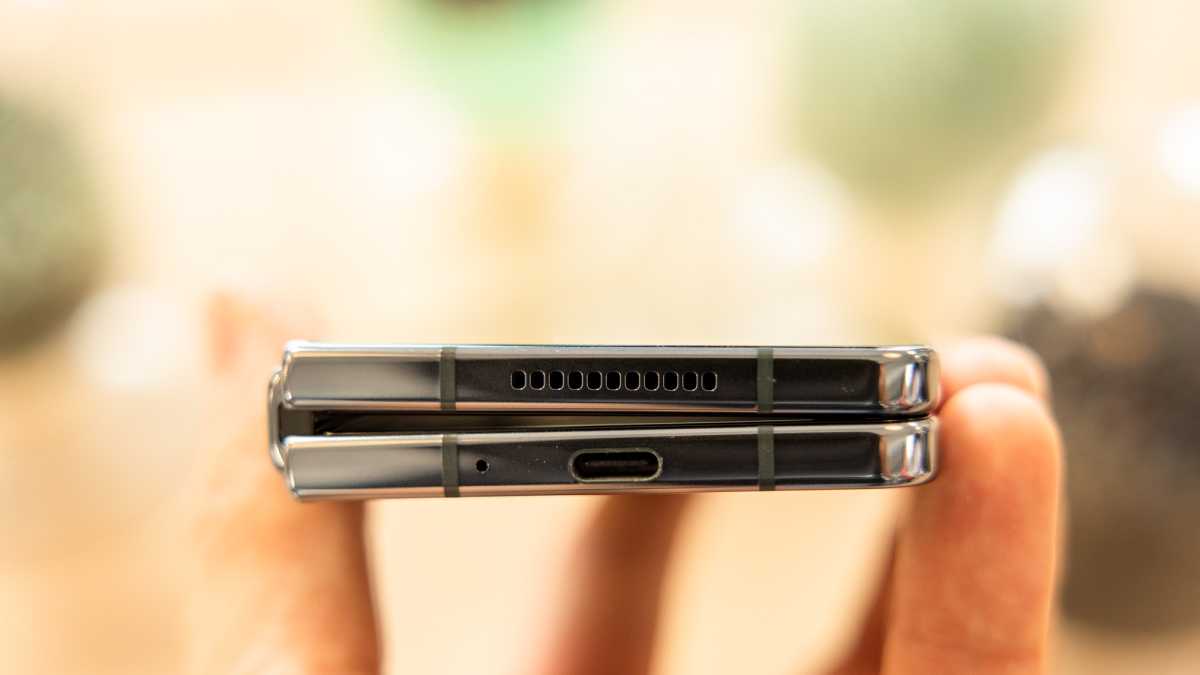Apple has never been especially interested in doing things first, which is unusual for a technology company, particularly one worth trillions of dollars. It likes to do things right. It likes to do things when it’s good and ready.
The original iPhone was one example of this, as much as the company’s cheerleaders may try to retrospectively crown it as the world’s first smartphone. On the contrary, we had plenty of smartphones before then; they just weren’t very good. Apple found a market that was ripe for domination–sitting in that sweet spot where user interest was high and available product quality was low–and then came crashing in like a multitouch cannonball with a phone that executed the concept properly.
But the folding iPhone, which is a thing we talk about endlessly rather than a thing that actually exists in any verifiable form, has followed a different path. In theory, Apple has been playing its usual long game, watching, waiting, and moving behind the scenes while Samsung, Motorola, Oppo and the rest roll out their hyped products to get the market warmed up. But as Samsung unveils the fourth generation of its Galaxy Fold phone, the market has been nicely warm for a while now, and there’s no sign of a headlining act from Cupertino.
The Fold, getting old
As you’d expect with a new form factor, the Fold struggled in its early days. The original Fold was afflicted by terrible reviews, delays, screen defects, and software bugs, and was, quite frankly, a mess. But by the time the Galaxy Z Fold 3 rolled around, we saw Samsung settling down and honing. Rather than fixing major problems, it was fine-tuning the design and bringing down the price. This week’s Z Fold 4, meanwhile, offers a faster processor, an improved camera and a slimmer chassis. These are the sort of upgrades you expect with a mature device, not something that’s new and risky.
 https://b2c-contenthub.com/wp-content/uploads/2022/08/Samsung-Galaxy-Fold-5-_review_12.jpg?resize=300%2C168&quality=50&strip=all 300w, https://b2c-contenthub.com/wp-content/uploads/2022/08/Samsung-Galaxy-Fold-5-_review_12.jpg?resize=768%2C432&quality=50&strip=all 768w, https://b2c-contenthub.com/wp-content/uploads/2022/08/Samsung-Galaxy-Fold-5-_review_12.jpg?resize=1200%2C675&quality=50&strip=all 1200w, https://b2c-contenthub.com/wp-content/uploads/2022/08/Samsung-Galaxy-Fold-5-_review_12.jpg?resize=1536%2C864&quality=50&strip=all 1536w, https://b2c-contenthub.com/wp-content/uploads/2022/08/Samsung-Galaxy-Fold-5-_review_12.jpg?resize=1240%2C697&quality=50&strip=all 1240w, https://b2c-contenthub.com/wp-content/uploads/2022/08/Samsung-Galaxy-Fold-5-_review_12.jpg?resize=150%2C84&quality=50&strip=all 150w" width="1200" height="675" sizes="(max-width: 1200px) 100vw, 1200px" />
https://b2c-contenthub.com/wp-content/uploads/2022/08/Samsung-Galaxy-Fold-5-_review_12.jpg?resize=300%2C168&quality=50&strip=all 300w, https://b2c-contenthub.com/wp-content/uploads/2022/08/Samsung-Galaxy-Fold-5-_review_12.jpg?resize=768%2C432&quality=50&strip=all 768w, https://b2c-contenthub.com/wp-content/uploads/2022/08/Samsung-Galaxy-Fold-5-_review_12.jpg?resize=1200%2C675&quality=50&strip=all 1200w, https://b2c-contenthub.com/wp-content/uploads/2022/08/Samsung-Galaxy-Fold-5-_review_12.jpg?resize=1536%2C864&quality=50&strip=all 1536w, https://b2c-contenthub.com/wp-content/uploads/2022/08/Samsung-Galaxy-Fold-5-_review_12.jpg?resize=1240%2C697&quality=50&strip=all 1240w, https://b2c-contenthub.com/wp-content/uploads/2022/08/Samsung-Galaxy-Fold-5-_review_12.jpg?resize=150%2C84&quality=50&strip=all 150w" width="1200" height="675" sizes="(max-width: 1200px) 100vw, 1200px" />Dominik Tomaszewski / Foundry
Granted, the Galaxy Z Fold 4 (which you can pre-order here) doesn’t look terribly different than the original Galaxy Fold. It’s a little thinner, a little more practical, and a little cheaper, but Samsung has stuck with its original vision of an overly skinny and thick phone that opens into a larger tablet. Samsung says it has sold some 10 million foldable devices over the past three years, which includes the less expensive Galaxy Flip, but there’s a sense that the market is still very much untested and uncertain.
In some ways that’s a difficult position for Samsung, which now has to come up with convincing reasons for customers to upgrade from previous generations and woo new customers who may be skeptical. But it also lets the company rest a bit. With virtually no competition, Samsung’s innovation with the Fold has been stagnant: There’s still a crease in the center of the screen, there still isn’t a slot for the S Pen, and there’s still a gap when closed. And at $1,799, it’s still very expensive.
It’s easy to see why Apple would never sell a flagship iPhone with the same flaws. New Apple devices may be rough around the edges—the first iPhone didn’t even have an App Store and the original Apple Watch relied on an iPhone to run apps—but the hardware is always rock solid. Software can evolve and mature, but hardware is forever.
But still, people seem to like Samsung’s folding phones. Even if Apple gets it right, launching a folding iPhone now would be an enormous challenge, with rivals experienced at making reliable foldables and customers having built up loyalty to specific devices. With no folding iPhone in sight for at least 2-3 years, the foldable revolution is close to passing Apple by, if it hasn’t already.
Waiting for the iFold
So what’s Apple’s grand plan? Is it seriously going to give up on the foldables market completely? Perhaps. But that’s more of a gamble than it might seem.
Because for all the tech media’s understandable cynicism about hype and points of failure, foldables could become a widely prevailing or even dominant form factor. After all, a foldable screen is in principle the ideal design for a phone, one that combines a large work space with a compact chassis. It simply faces practical problems in delivering that design–and if you wait long enough, as Apple is doing, those practical problems start to vanish.
 https://b2c-contenthub.com/wp-content/uploads/2022/08/Samsung-Galaxy-Fold-5-_review_2.jpg?resize=300%2C168&quality=50&strip=all 300w, https://b2c-contenthub.com/wp-content/uploads/2022/08/Samsung-Galaxy-Fold-5-_review_2.jpg?resize=768%2C432&quality=50&strip=all 768w, https://b2c-contenthub.com/wp-content/uploads/2022/08/Samsung-Galaxy-Fold-5-_review_2.jpg?resize=1200%2C675&quality=50&strip=all 1200w, https://b2c-contenthub.com/wp-content/uploads/2022/08/Samsung-Galaxy-Fold-5-_review_2.jpg?resize=1536%2C864&quality=50&strip=all 1536w, https://b2c-contenthub.com/wp-content/uploads/2022/08/Samsung-Galaxy-Fold-5-_review_2.jpg?resize=1240%2C697&quality=50&strip=all 1240w, https://b2c-contenthub.com/wp-content/uploads/2022/08/Samsung-Galaxy-Fold-5-_review_2.jpg?resize=150%2C84&quality=50&strip=all 150w" width="1200" height="675" sizes="(max-width: 1200px) 100vw, 1200px" />
https://b2c-contenthub.com/wp-content/uploads/2022/08/Samsung-Galaxy-Fold-5-_review_2.jpg?resize=300%2C168&quality=50&strip=all 300w, https://b2c-contenthub.com/wp-content/uploads/2022/08/Samsung-Galaxy-Fold-5-_review_2.jpg?resize=768%2C432&quality=50&strip=all 768w, https://b2c-contenthub.com/wp-content/uploads/2022/08/Samsung-Galaxy-Fold-5-_review_2.jpg?resize=1200%2C675&quality=50&strip=all 1200w, https://b2c-contenthub.com/wp-content/uploads/2022/08/Samsung-Galaxy-Fold-5-_review_2.jpg?resize=1536%2C864&quality=50&strip=all 1536w, https://b2c-contenthub.com/wp-content/uploads/2022/08/Samsung-Galaxy-Fold-5-_review_2.jpg?resize=1240%2C697&quality=50&strip=all 1240w, https://b2c-contenthub.com/wp-content/uploads/2022/08/Samsung-Galaxy-Fold-5-_review_2.jpg?resize=150%2C84&quality=50&strip=all 150w" width="1200" height="675" sizes="(max-width: 1200px) 100vw, 1200px" />The Galaxy Z Fold 4 still has a gap when closed.
Dominik Tomaszewski / Foundry
Let me put it another way. Imagine the tech landscape of 2030. What’s the main device each person is using in their daily life? It could be the iPhone 21 Pro Max with the same form factor and a better camera, but it’s more likely to be something entirely new, such as VR/AR headsets. Perhaps something we’ve seen already will have evolved to take on a broader role: the Apple Watch, for example, if Apple can find a way around the screen-size limitation. But no matter what, it’s difficult to imagine everyone will still be carrying smartphones with the same design as the iPhone 13.
Foldable smartphones have at least a shot at being the universal device of the future, and it worries me that Apple seems to be doing so little to prepare for that future. It’s one thing to be fashionably late, but when it comes to foldables, Apple runs the risk of turning up to the party and finding that all the seats are taken.





